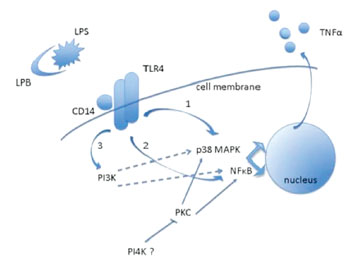Immune Function Predicts Infection for Pediatric Trauma Patients
By LabMedica International staff writers
Posted on 23 Jul 2014
An immune marker that predicts which patients are likely to develop a hospital-acquired infection has been identified in critically ill children with traumatic injuries.Posted on 23 Jul 2014
The clinical implementation of quick-turnaround immune function tests and treatments to prevent or reverse immune system damage following critical illness or injury in pediatric patients is essential. This especially true where hospital-acquired, or nosocomial, infections pose a threat to any patient, but people who have suffered a traumatic injury are at the highest risk.

Image: Schematic representation of signaling pathways involved in lipopolysaccharide (LPS) induced tumor necrosis factor-alpha (TNFα) production in human cells (Photo courtesy of Dr. Laurence Hoareau).
Clinical scientists at the Nationwide Children's Hospital (Columbus, OH, USA) collected blood samples from 21 healthy children and 76 critically injured children, 18 years of age or younger. In a test tube, they exposed each sample to lipopolysaccharide (LPS), a known stimulant of the immune response. When healthy cells are exposed to LPS, it prompts the production of tumor necrosis factor-alpha (TNFα), a type of protein called a cytokine that is part of the first line of defense in the body's innate immune system.
Sixteen critically injured subjects developed nosocomial infection. Those subjects had higher plasma interleukin (IL)-6 and IL-10 levels on post-trauma day (PTD) 1-2 compared to those who recovered without infection and outpatient controls. Ex vivo LPS-induced TNFα production capacity was lower in children on PTD 1-2 and over the first week following injury in those who went on to develop infection. The team found that patients who received a transfusion of blood that had been stored for more than two weeks prior to transfusion had a lower level of TNFα production than children whose transfused blood was less than two weeks old, regardless of the severity of their original injury.
The authors concluded that trauma-induced innate immune suppression is common in critically injured children and is associated with increased risks for the development of nosocomial infection. Potential exacerbating factors, including red blood cell transfusion and potential therapies for pediatric trauma-induced innate immune suppression are deserving of further study.
Mark W. Hall, MD, the senior author of the study said, “With a normal immune response, the body responds to pathogens and eliminates them before they cause an infection. But in many forms of critical illness, we see the immune system unable to do those things. Studies in adults with traumatic injuries have found that immune function is decreased in those patients, but this is the first data to show that the same thing happens in critically injured children.” The study was published on June 21, 2014, in the journal Shock.
Related Links:
Nationwide Children's Hospital














